Traditional Focaccia Bread
A traditional focaccia bread recipe that bakes up crisp on the outside and warm and soft on the inside. With endless topping options you can easily make this focaccia recipe your own by simply changing out how you dress it up! Perfect for serving with soups and stews, or even for making into sandwiches.

I don’t think there is much that can beat a fresh-baked loaf of bread. Whether it’s a slice of warm homemade white bread, classic Italian bread, an airy ciabatta, or a cheesy slice of garlic bread you truly can’t go wrong. One of the bread recipes I thoroughly enjoy making, especially during the winter months, is traditional focaccia.
Focaccia has always been one of my favorite bakery splurges, with the crusty exterior and soft interior, plus tons of flavor from the herbs and garlic are just heavenly. The traditional Italian bread can also double as a flatbread or pizza dough but is most commonly served as an appetizer bread or side to soup or salad.
What is Focaccia?
This flat, oven-baked Italian bread is often referred to as Italian flatbread or pizza Bianca. It’s a dimpled dough loaded with olive oil and various seasonings and toppings.
Focaccia is most commonly compared to pizza dough. They are both flat, oven-baked bread that often includes different toppings. One of the main differences between the two breads is rise time. Focaccia gets an extra rise after being flattened out while pizza dough bakes immediately after flattening.
How to Make Focaccia
I’ve tried many, many recipes and always come back to this classic from Peter Reinhart’s The Bread Baker’s Apprentice. It bakes up perfectly every single time and is packed full of flavor. The olive oil creates a crisp exterior while the interior remains soft and fluffy.
When you look at this recipe, it will seem very time-intensive, but nearly all of the time is rest time with very little hands-on work. Let’s talk through the recipe…
Ingredients
- Herb Oil – Made with olive oil, fresh or dry herbs, kosher salt, black pepper, and minced garlic.
- Bread Flour – Using bread flour gives the focaccia a chewy texture; you can substitute all-purpose flour without ruining the recipe, but your bread will be significantly lighter and missing that characteristic texture.
- Salt – Gives flavor to the dough.
- Instant Yeast – Feeds on the sugars activated in the flour and helps the focaccia rise.
- Olive Oil – Used both in and on the dough helps tenderize the dough and gives the toppings something to stick to on the bread.
- Water – Activates the yeast and turns your ingredients into a dough.
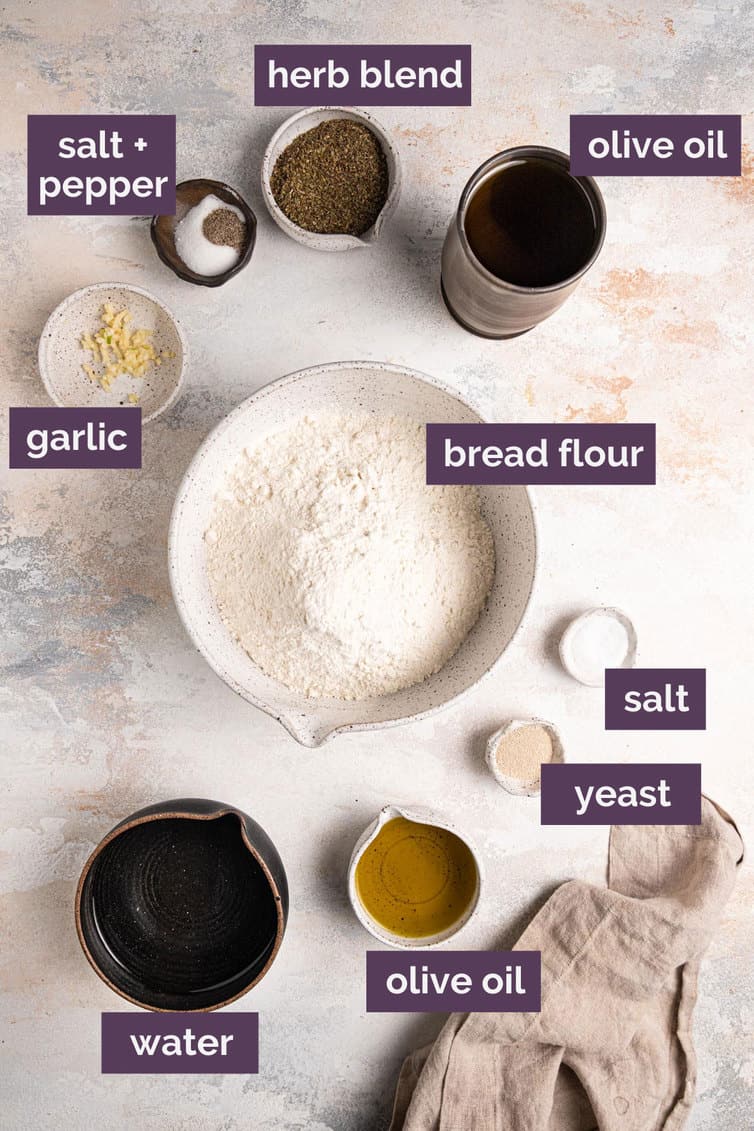
Make the Herb Oil
This is what infuses the bread with tons of flavor and gives it that characteristic texture. There are lots of flavor modifications and additions you can make to suit your tastes, so be sure to check the recipe notes below. To make herb oil:
- Heat Olive Oil: Warm 2 cups of olive oil in a small saucepan over low heat to 100°F (this only takes a few minutes).
- Season Olive Oil: Add the herbs, salt, pepper, and garlic; stir together.
- Steep Herb Oil: Remove from heat and allow to steep while you prepare the dough.
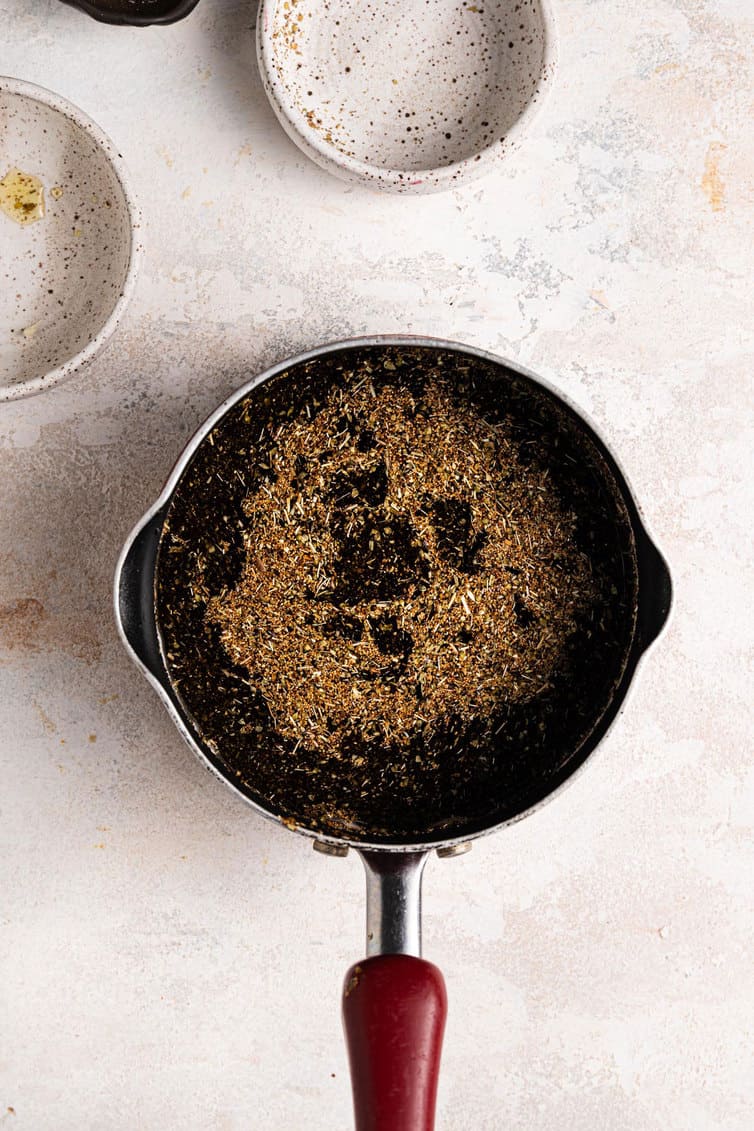
Herb Oil Notes:
- Herbs – If using fresh herbs, use any combination of basil, parsley, oregano, tarragon, rosemary, thyme, cilantro, and sage. If using dried herbs, you can use a combination of any of the previous herbs, or use a blend such as herbes de Provence. You can substitute 1 tablespoon granulated garlic for the fresh garlic.
- Herb Oil Extras – You can also add 1 teaspoon paprika, 1 teaspoon cayenne pepper, 1 tablespoon fennel seeds, 1 teaspoon onion powder, or 1 tablespoon dried, minced onions.
- Herb Oil Storage – Keep any leftover herb oil in the refrigerator for up to 2 weeks (it makes a wonderful dipping oil!).
Make the Focaccia Dough
- Mix the dough: Stir together flour, salt, and yeast in the bowl of an electric mixer. Add the olive oil and water and mix on low speed with the paddle attachment until it forms a wet, sticky ball.
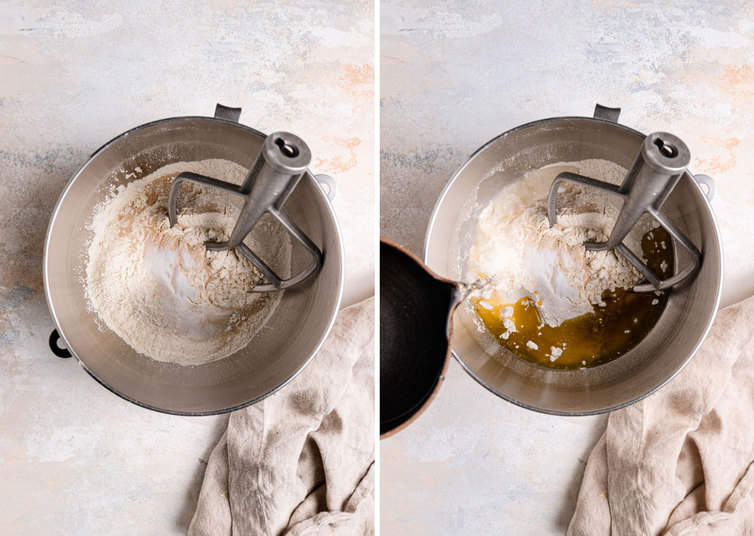
- Knead the dough: Switch to a dough hook and mix on medium for 5-7 minutes to form a smooth, sticky dough. The dough should clear the sides of the bowl but stick to the bottom of the bowl. Add additional flour to firm up the dough enough to clear the sides of the bowl.

- Transfer and stretch the dough: Sprinkle workspace with a 6-inch square bed of flour. Transfer dough to the flour bed and dust liberally with flour. Pat dough into a rectangle and allow to rest 5 minutes. Coat your hands with flour and stretch the dough from each end to twice its size.

- Shape the dough: Fold it, letter style, over itself to return to a rectangular shape. Mist with olive oil or non-stick spray, dust with flour, and cover with plastic wrap. Allow dough to rest for 30 minutes.
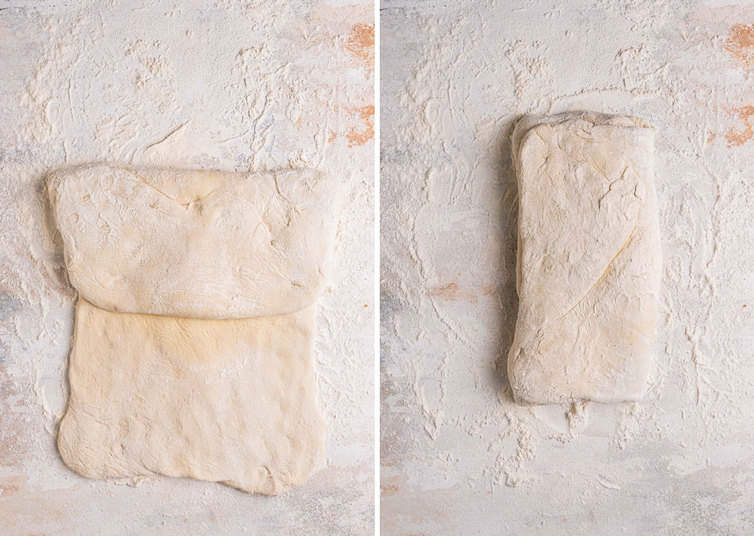
- Stretch and Fold: Again, stretch the dough to twice its size and fold over, letter style, to return to a rectangular shape. Repeat the mist, flour, and cover, and allow to rest for 30 minutes.
Save This Recipe
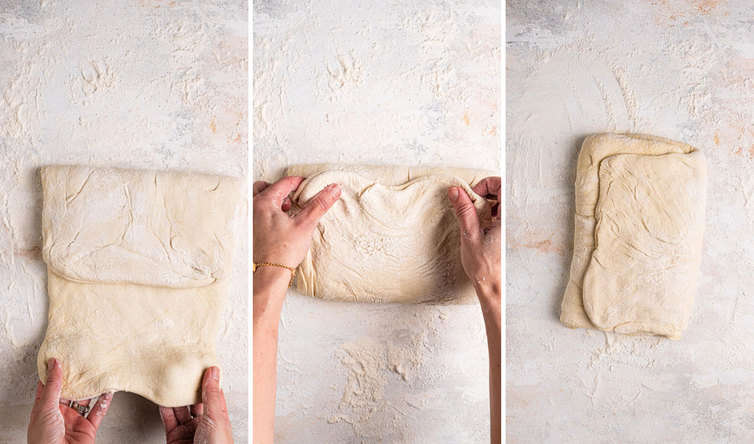
- The final stretch: Once more, stretch and fold the dough. Cover loosely with plastic wrap and allow to ferment on the work surface for 1 hour. It should swell but not necessarily double in size.
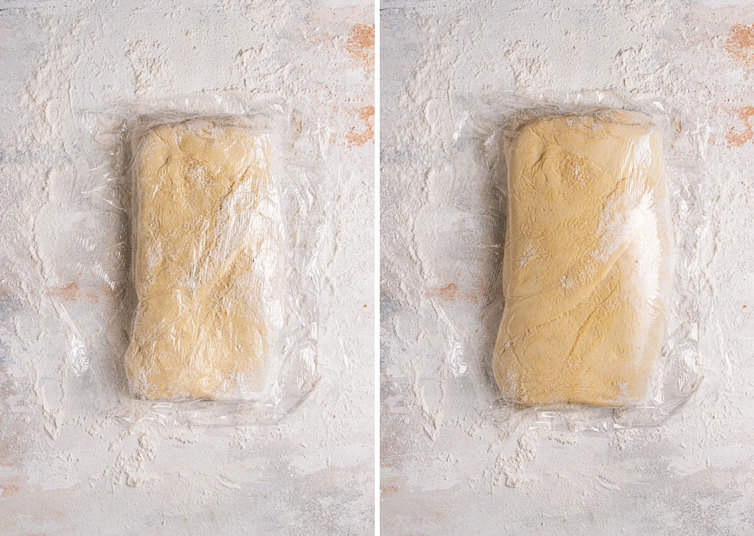
- Prepare the baking sheet: Line a half sheet pan with parchment paper. Drizzle 1/4 cup olive oil over the paper, and spread it with your hands or a brush to cover the surface. Lightly oil your hands and using a plastic dough spatula, transfer the dough to the sheet pan, maintaining the rectangular shape as much as possible. Spoon half the herb oil over the dough.
- Dimple the dough: Use your fingertips to dimple the dough and spread it to fit the pan. If the dough becomes too springy, let it rest for 15 minutes and then continue dimpling. Don’t worry if you are not able to completely fill the pan, especially the corners. Use more herb oil as needed to ensure the entire surface is coated.
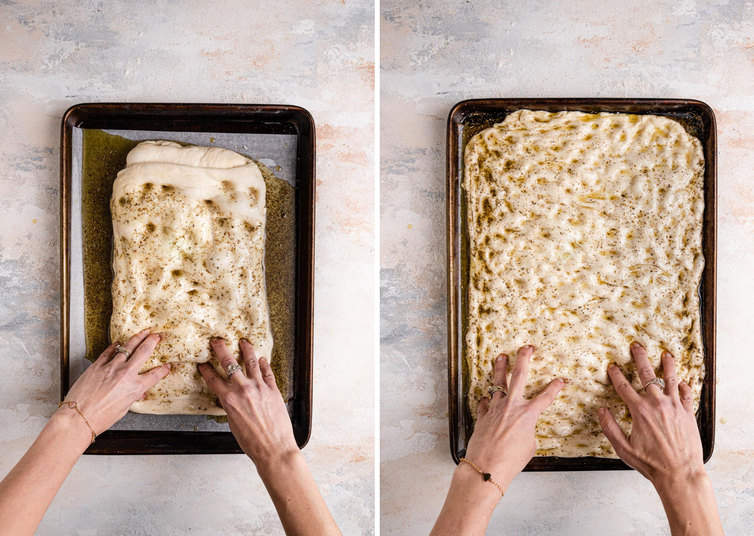
- Refrigerate overnight: Cover the pan with plastic wrap lightly and refrigerate overnight or up to 3 days.
How to Bake the Focaccia
- Remove from the refrigerator: Remove the pan from the refrigerator 3 hours before baking.
- Proof the dough: Drizzle with additional herb oil and dimple it in. Optional- add any pre-proof toppings (see below). Cover with plastic wrap and proof at room temperature for 3 hours. The dough should double in size and be about 1 inch thick.
- Preheat the oven: Set the oven to 500°F and top the focaccia with any optional pre-bake toppings (see below)
- Bake the focaccia: Place the pan in the oven and lower the temperature to 45o°F and bake for 10 minutes. Rotate the pan 180° and bake 5-10 more minutes, or until golden brown. If you are using any optional during-bake toppings, sprinkle them on at this point and continue baking for an additional 5 minutes.
- Remove the focaccia: Remove the pan from the oven and transfer the focaccia out of the pan and onto a cooling rack. Allow the focaccia to cool for 20 minutes before slicing or serving.
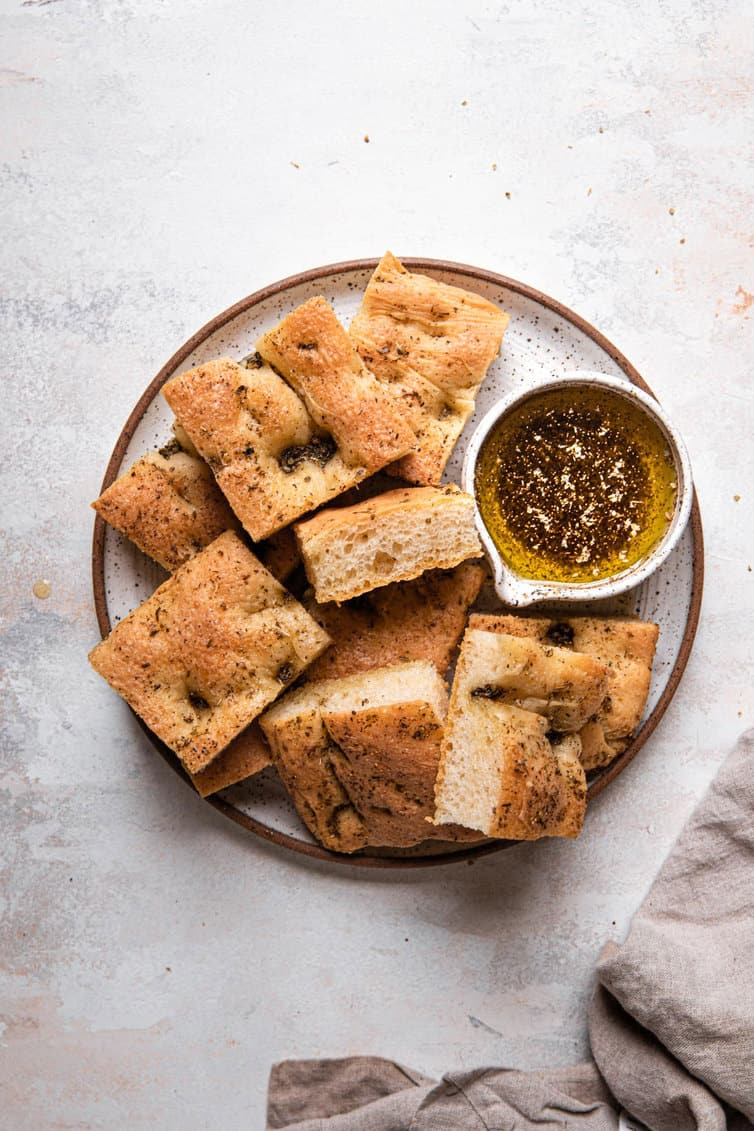
Focaccia Bread Success Tips
- Make the Dough By Hand – The dough can be prepared without a stand mixer by mixing the dough with a large metal spoon in lieu of the kneading step. You will need to mix vigorously for about 3 to 5 minutes, or until the dough is smooth and the ingredients are evenly distributed.
- Gentle Dimpling – When dimpling the dough, be sure to use ONLY your fingertips and not the flat of your hands to avoid tearing or ripping the dough. This helps reduce the air in the dough and prevents the bread from rising too quickly.
- Picking Olive Oil – Pick an extra virgin olive oil that works well in cooking and baking. You do not want to use a finishing oil in the dough or during the baking process.
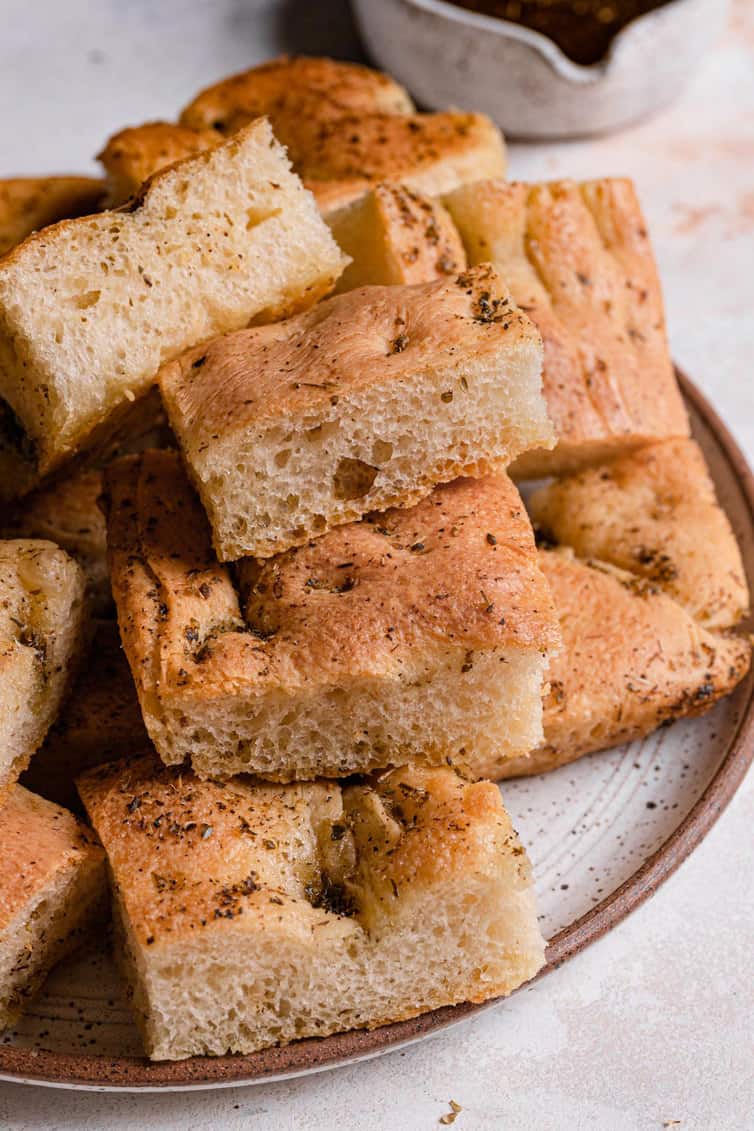
Topping Ideas for Focaccia
There are various points in the recipe when you can add toppings to your focaccia. Here are just a few suggestions for topping focaccia bread pre-proof, pre-bake, and during baking.
- Pre-Proof Topping Ideas:
- Sun-dried tomatoes
- Olives
- Roasted garlic
- Fresh herbs
- Walnuts, pine nuts, or other nuts
- Sauteed mushrooms, bell peppers, or onions
- Pre-Bake Topping Ideas:
- Soft cheeses – Blue cheese, fresh mozzarella, and feta
- Cooked ground meat
- Strips of deli meat
- Coarse salt
- Coarse sugar
- During-Bake Topping Ideas:
- Dry or semihard cheeses – Parmesan, Romano, regular mozzarella, Monterey Jack, Cheddar, and Swiss
Serving Ideas
No matter how you choose to serve it, I can promise you with 100% certainty that making it at home is a thousand times better than buying it somewhere. You can easily make this bread with any soup or chili recipe. I also love serving my focaccia with:

Freezing, Storing and Reheating Tips
- Freeze Before Baking – If you wish to prepare the dough in advance, complete steps #1 through 7. After the 1 hour rise, wrap tightly in plastic wrap, place in a freezer-safe bag, and freeze for up to 3 months. Thaw overnight in the refrigerator, then proceed with the rest of the recipe.
- Freeze After Baking – Wrap individual slices of focaccia in plastic wrap, then in foil, and place in a freezer-safe bag. Freeze for up to 1 month. Thaw at room temperature and, if desired, reheat in a 325-degree oven for 5 minutes, or until warmed through and crispy.
- Storage – The focaccia is best the day it is made, but it can be stored, tightly covered, at room temperature for up to 2 days.
- Reheating – While I think this focaccia is best right after baking, you can easily bring it back to life by baking in the oven at 350°F for about 8-10 minutes.
Other Bread to Bake Next:
- Basic Pizza Dough
- Homemade Pita Bread
- Italian Bread
- Potato Rosemary Bread
- 10 Best Yeast Bread Recipes
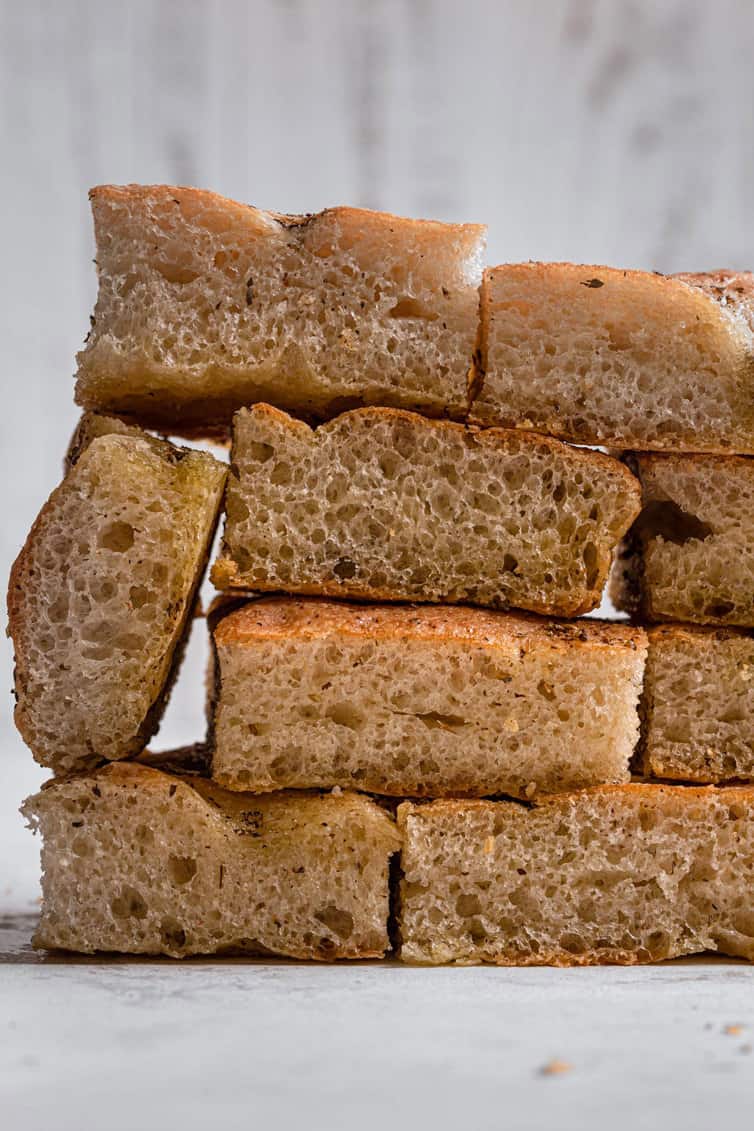
Golden and dimpled on the outside with a soft tender interior, this focaccia makes the perfect side to your soups, stews, or hearty pasta. Slice it up and serve it with olive oil or herb oil, you truly can’t go wrong!
Watch How to Make This Classic Focaccia Bread:
If you make this recipe and love it, remember to stop back and give it a 5-star rating - it helps others find the recipe! ❤️️
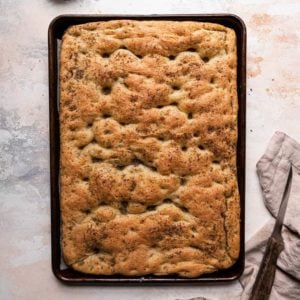
Focaccia Bread
Ingredients
For the Herb Oil:
- 2 cups olive oil
- 1 cup chopped fresh herbs, OR 1/3 cup dried herbs
- 1 tablespoon kosher salt
- 1 teaspoon ground black pepper
- 6 cloves garlic, minced
For the Dough:
- 5 cups (638 g) high-gluten or bread flour
- 2 teaspoons salt
- 2 teaspoons instant yeast
- 6 tablespoons olive oil
- 2 cups (480 ml) water, at room temperature
For Preparation
- ¼ cup olive oil
- Pre-proof toppings, optional
- Pre-bake toppings, optional
- During-bake toppings, optional
Instructions
- Make the Herb Oil: Warm 2 cups olive oil in a small saucepan over low heat to 100 degrees F (this only takes a few minutes). Add the herbs, salt, pepper, and garlic; stir together, remove from the heat and allow to steep while you prepare the dough.
- Make the Dough: Stir together the flour, salt, and yeast in the bowl of an electric mixer. Add the oil and water and mix on low speed with the paddle attachment until all of the ingredients form a wet, sticky ball.
- Switch to the dough hook and mix on medium speed for 5 to 7 minutes, or as long as it takes to create a smooth, sticky dough. The dough should clear the sides of the bowl but stick to the bottom of the bowl. You may need to add additional flour to firm up the dough enough to clear the sides of the bowl, but the dough should still be quite soft and sticky.
- Sprinkle enough flour on a clean work surface to make a bed about 6 inches square. Using a dough spatula or bench scraper dipped in water, transfer the sticky dough to the bed of flour and dust liberally with flour, patting the dough into a rectangle. Allow the dough to rest for 5 minutes.
- Coat your hands with flour and stretch the dough from each end to twice its size. Fold it, letter style, over itself to return it to a rectangular shape. Mist the top of the dough with spray oil or nonstick cooking spray, again dust with flour, and loosely cover with plastic wrap. Allow the dough to rest for 30 minutes.
- Stretch and fold the dough again; mist with oil, dust with flour, and cover loosely with plastic wrap. Allow the dough to rest for 30 minutes.
- Once more, stretch and fold the dough. Cover loosely with plastic wrap and allow to ferment on the work surface for 1 hour. It should swell but not necessarily double in size.
- Line a half sheet pan with parchment paper. Drizzle ¼ cup olive oil over the paper, and spread it with your hands or a brush to cover the surface. Lightly oil your hands and, using a plastic dough spatula or bench scraper, lift the dough from the work surface and transfer it to the sheet pan, maintaining the rectangular shape as much as possible. Spoon half of the herb oil over the dough.
- Use your fingertips to dimple the dough and spread it to fill the pan. If the dough becomes too springy, let it rest for 15 minutes and then continue dimpling. Don't worry if you aren't able to completely fill the pan, especially the corners. User more herb oil as needed to ensure that the entire surface is coated with oil.
- Loosely cover the pan with plastic wrap and refrigerate overnight (or up to 3 days).
- Remove the pan from the refrigerator 3 hours before baking.
- Drizzle additional herb oil over the surface and dimple it in (you can use all of the herb oil if you want; the dough will absorb it even though it looks like a lot). The pan should be filled completely with the dough and the dough should have a thickness of about ½-inch. Add any other pre-proof toppings (see notes below). Cover the pan with plastic wrap and proof at room temperature for 3 hours, or until the dough double in size, rising to a thickness of nearly 1 inch.
- Preheat oven to 500 degrees F. Gently place any pre-bake toppings on the dough (see notes below).
- Place the pan in the oven. Immediately lower the oven temperature to 450 degrees F and bake for 10 minutes. Rotate the pan 180 degrees and continue baking for 5 to 10 minutes, or until it begins to turn a light golden brown. If you are using any during-bake toppings (see notes below), sprinkle them on at this point and continue baking an additional 5 minutes or so. The internal temperature of the dough should register at least 200 degrees F on an instant-read thermometer.
- Remove the pan from the oven and immediately transfer the focaccia out of the pan onto a cooling rack. Allow the focaccia to cool for at least 20 minutes before slicing or serving.
Notes
- Herb Oil – If using fresh herbs, use any combination of basil, parsley, oregano, tarragon, rosemary, thyme, cilantro, and sage. If using dried herbs, you can use a combination of any of the previous herbs, or use a blend such as herbes de Provence. You can substitute 1 tablespoon granulated garlic for the fresh garlic.
- Herb Oil Extras – You can also add 1 teaspoon paprika, 1 teaspoon cayenne pepper, 1 tablespoon fennel seeds, 1 teaspoon onion powder, or 1 tablespoon dried, minced onions.
- Herb Oil Storage – Keep any leftover herb oil in the refrigerator for up to 2 weeks (it makes a wonderful dipping oil!).
- Make the Dough By Hand – The dough can be prepared without a stand mixer by mixing the dough with a large metal spoon in lieu of the kneading step. You will need to mix vigorously for about 3 to 5 minutes, or until the dough is smooth and the ingredients are evenly distributed.
- Gentle Dimpling – When dimpling the dough, be sure to use ONLY your fingertips and not the flat of your hands to avoid tearing or ripping the dough.
- Pre-Proof Topping Ideas:
-
- Sun-dried tomatoes
- Olives
- Roasted garlic
- Fresh herbs
- Walnuts, pine nuts, or other nuts
- Sauteed mushrooms, bell peppers, or onions
-
- Pre-Bake Topping Ideas:
-
- Soft cheeses – Blue cheese, fresh mozzarella, and feta
- Cooked ground meat
- Strips of deli meat
- Coarse salt
- Coarse sugar
-
- During-Bake Topping Ideas:
-
- Dry or semihard cheeses – Parmesan, Romano, regular mozzarella, Monterey Jack, Cheddar, and Swiss
-
- Freeze Before Baking – If you wish to prepare the dough in advance, complete steps #1 through 7. After the 1 hour rise, wrap tightly in plastic wrap, place in a freezer-safe bag, and freeze for up to 3 months. Thaw overnight in the refrigerator, then proceed with the rest of the recipe.
- Freeze After Baking – Wrap individual slices of focaccia in plastic wrap, then in foil, and place in a freezer-safe bag. Freeze for up to 1 month. Thaw at room temperature and, if desired, reheat in a 325-degree oven for 5 minutes, or until warmed through and crispy.
- Storage – The focaccia is best the day it is made, but it can be stored, tightly covered, at room temperature for up to 2 days.
- Recipe from The Bread Baker’s Apprentice
Did you make this recipe?
Leave a review below, then snap a picture and tag @thebrowneyedbaker on Instagram so I can see it!
Photography by Dee Frances


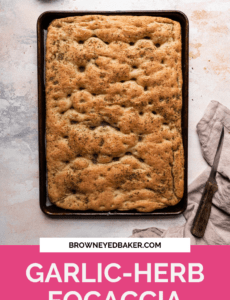



If I half the recipe do I half the yeast too?
Hi Mae, Yes, you should halve all of the ingredients.
Just made your recipe….Came out AMAZING….Thanks for sharing~! I spread some basil pesto over it and pressed that in ….YUM…….it added a great flavor~! It was a large amount of dough so I only cut off a piece big enough for today…I’ll leave the rest in the fridge and we can enjoy it again tomorrow~!! Whoop Whoop….
would this work if I split the dough into 2 9×11″ pans? when I moved I mysteriously lost about half of everything from my kitchen so I don’t have a lot to work with.
Hi Aurea, I don’t see why that wouldn’t work. Enjoy the bread!
This was AMAZING! I made this specifically to use for sandwiches and it was a huge success. Used it for grilled fish and aioli sandwiches, plain grilled chickenbreast sandwiches, and brie/tomato/lettuce sandwiches. Now I need to make more:) Great recipe!
Just made this, it turned out beautifully, and the family loved it! I added the herb oil into the dough as well, to amp up the flavour. Thanks for the detailed instructions! I’ll be making this again and again :D
I have finally risen to the occassion and made this Foccacia. Having avoided recipes which even contained the word Yeast for 50 yrs, I have finally decided to meet it head on. What a success this was. I am thrilled with the results and will carry on and try a few other recipes.
Hi Michelle,
How long will the focaccia be good for before I have to put it in the fridge?
Hi Liz, Usually 2-3 days (max) is about as long as you can get out of fresh bread before it starts to get stale.
Made this and it turned out AMAZING thank you!
I can’t seem to find the recipe to print on your website. I want to email the link to a friend. Thanks!
Hi Kate, So sorry about that glitch, it’s there now!
Hi!
Loved your post on Focaccia bread! I’ve been searching for a recipe and have no experience making this type of bread. There are so many recipes with different proportions and style of making it. Do you find that the waiting and kneading is what makes it the consistency you desire? I was looking on food network and it doesn’t seem that Emeril waits! hah! Just looking for pointers, can’t wait to try it!
Hi Rachelle, I haven’t yet made a bread recipe with yeast that doesn’t require at least one rise. You definitely need it to achieve the best texture. Sometimes the best things require a little wait :)
Love it and the pictures make this focaccia look so appealing. I had to share this with our Facebook fans. Thank you and keep up the nice work!
I love making bread. I love focaccia and haven’t made it in ages. Your focaccia is beautiful. I will make it soon. Haven’t made any bread this year – not yet. Love the inspiration!
I need to know if I can use herb de province with sea salt (William Sonoma) in place of the herbs and salt in the recipe and would I still need to use the same amount?
Hi Barbara, I would probably just omit the salt in the recipe and you should be fine. Enjoy!
Love this! And I’ve been inspired to feature your focaccia in my Friday Food Fetish roundup and on Pinterest. I can’t wait to see what you come up with next and please let me know if you have any objections…
No objections at all; thank you for including me!
The first bread I ever tried my hand at was focaccia and it turned out so well! I can’t wait to give this one a try too. It’s also in my new year’s resolution to start making more bread. I got a Kitchen Aid stand mixer for Christmas with the intention of using it for lots of yeast things!
This is one of my favorite breads to bake! It’s easy and taste amazing! ♥
I had somehow forgotten about the focaccia I recently made, now I want to make more. Curses! Teasing of course ;)
My husband got me The Bread Baker’s Apprentice for Christmas! I have not made anything from it yet because I just can’t decide where to start; I think I have discovered my starting point! :) Did you need to adjust the baking time because you used a smaller pan?
Hi Katie, I took it out a couple of minutes early, so not too much. I think it could have gone the whole way, it would have just been a bit more golden.
Oh, that looks delicious!
* first time reader
Hi Melanie, Thank you and welcome to the site!
This looks yummy! I might give this a try this weekend.
Focaccia is one of my favourite breads to make. Yours looks so thick and delicious, ready to soak up a great pasta sauce :) yumm.
There is NOTHING quite like homemade focaccia! All warm and a little bit oily! Now you’ll never want to buy a loaf again…
I just love focaccia! It looks so delicious, too. Homemade stuff is so much better than store-bought, in every way.
OMG, Now I know why I like you so much. I bought my Bread Bakers Apprentice five years ago too, and have not made one thing from it, though I have wanted to multiple times. I am so going to make this my first attempt. I adore pizza, and hope they have it in heaven. I could live on the stuff, only a good one will do.
I LOVE Focaccia bread. It’s one of my favorites & is so versatile. Your version looks so fluffy and delicious!
I’m dying to dip this in some great marinara sauce! Do you think it would work to replace half the flour with whole wheat to make a healthier loaf? Or would it get weird?
Hi Lindsay, I would err on the side of not using the whole wheat flour. Peter Reinhart does a great job in his books of including any and all variations, substitutions, etc. but there are none for this recipe. I do know that there are a few bread books out there that focus on baking with whole grains, and they quite possibly would have recipes that include whole wheat flour – check out Healthy Bread in Five Minutes a Day and Good to the Grain: Baking with Whole-Grain Flours.
Peter Reinhart also has a whole grain breads book, “Peter Reinhart’s Whole Grain Breads: New Techniques, Extraordinary Flavor”, and there’s a whole wheat focaccia recipe in there.
I just posted my go-to focaccia recipe a couple weeks ago. It’s from Ciril Hitz and makes an incredibly light and airy focaccia. It too takes awhile but so worth it. My fave! I topped mine with caramelized onions…then made grilled cheese out of it. YUM! In the summer I do a similar herb oil. The possibilities are simply endless with this bread! I think focaccia is a great bread for those new to bread baking. Even though it does take a lot of waiting, there is no shaping, which is where I find a lot of people struggle. It’s pretty hard to screw up too! Hmm….now I want to make more :)
Focaccia bread is one of my favorites… and, this version looks as good as any I’ve seen. I definitely need to give it a try! It looks wonderful.
I have this same cookbook and just made this same focaccia recipe last week. I can totally agree that this bread is phenomenal! I too could hardly keep my hands off of it, especially when it came out warm from the oven. Later this week I’m planning to make it again but with pizza toppings for dinner. Can hardly wait for that meal! :)
This looks so good!